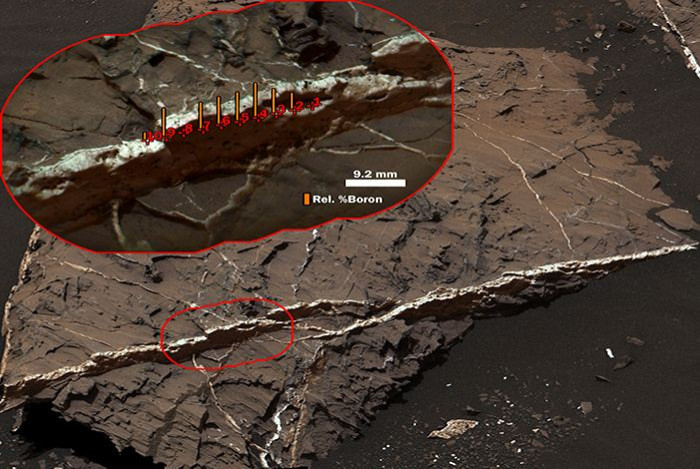Water On Mars: Discovery Of Boron Suggests The Planet Once Had Habitable Groundwater

NASA’s Curiosity rover has unearthed fresh evidence that Mars once had plentiful water on its surface. The rover, using its laser-shooting Chemistry and Camera (ChemCam) instrument, has detected boron on the surface of the red planet.
On Earth, boron, which is a water-soluble element, is a signature of evaporated water, and is thus found in sites like California’s Death Valley.
“If the boron that we found in calcium sulphate mineral veins on Mars is similar to what we see on Earth, it would indicate that the groundwater of ancient Mars that formed these veins would have been 0-60 degrees Celsius [32-140 degrees Fahrenheit] and neutral-to-alkaline pH,” Patrick Gasda, a postdoctoral researcher at Los Alamos National Laboratory in New Mexico, which was involved in the development of the ChemCam instrument, said in a statement last week. “No prior mission to Mars has found boron.”
The element was detected by Curiosity during its uphill trek on the slopes of Mount Sharp — a Mount-Rainier-size structure that the rover has been investigating for evidence of ancient water bodies by sampling progressively younger layers. Previous drilling operations carried out by Curiosity in the region have revealed that the formation consists primarily of mudstone, which is created when mud accumulates at the bottom of lakes.

“The discovery of boron is only one of several recent findings related to the composition of Martian rocks,” the Los Alamos National Laboratory said in the statement. “As the rover has progressed uphill, compositions trend toward more clay and more boron. These and other variations can tell us about conditions under which sediments were initially deposited and about how later groundwater moving through the accumulated layers altered and transported ingredients.”
We already know that Mars, currently a dusty and barren wasteland, was not always so. Data collected by the Mars Reconnaissance Orbiter and the Curiosity rover has bolstered the theory that roughly 4.3 billion years ago, Mars had enough water to cover its entire surface in a liquid layer about 450 feet deep.
Evidence also suggests that long after solar winds stripped the red planet of its atmosphere, turning it into the cold, arid world it is today, lakes of water and snowmelt-fed streams still existed on its surface.
“We are seeing chemical complexity indicating a long, interactive history with the water,” John Grotzinger, a professor of geology at the California Institute of Technology in Pasadena, said in the statement. “The more complicated the chemistry is, the better it is for habitability. The boron and clay underline the mobility of elements and electrons, and that is good for life.”
© Copyright IBTimes 2024. All rights reserved.






















